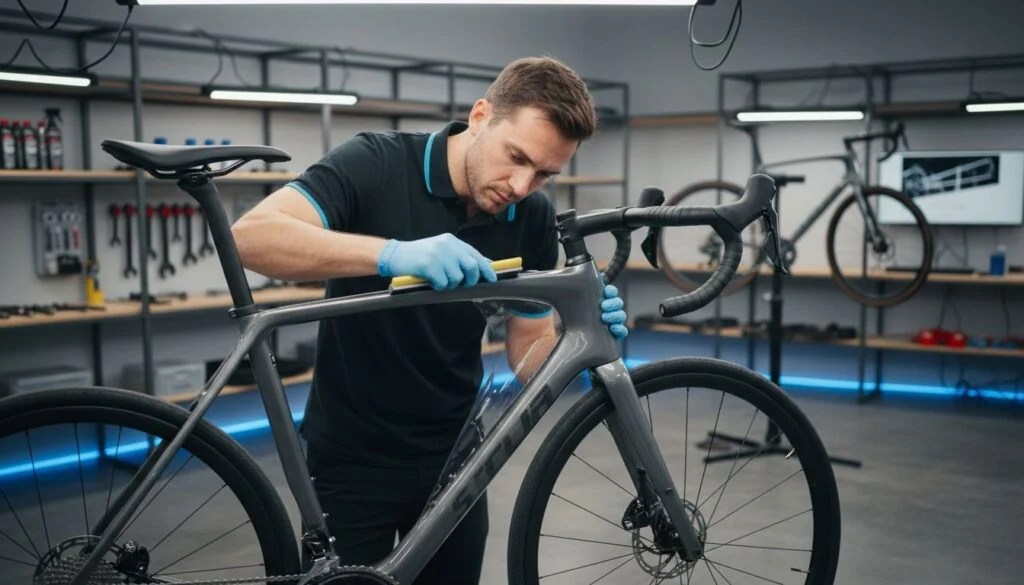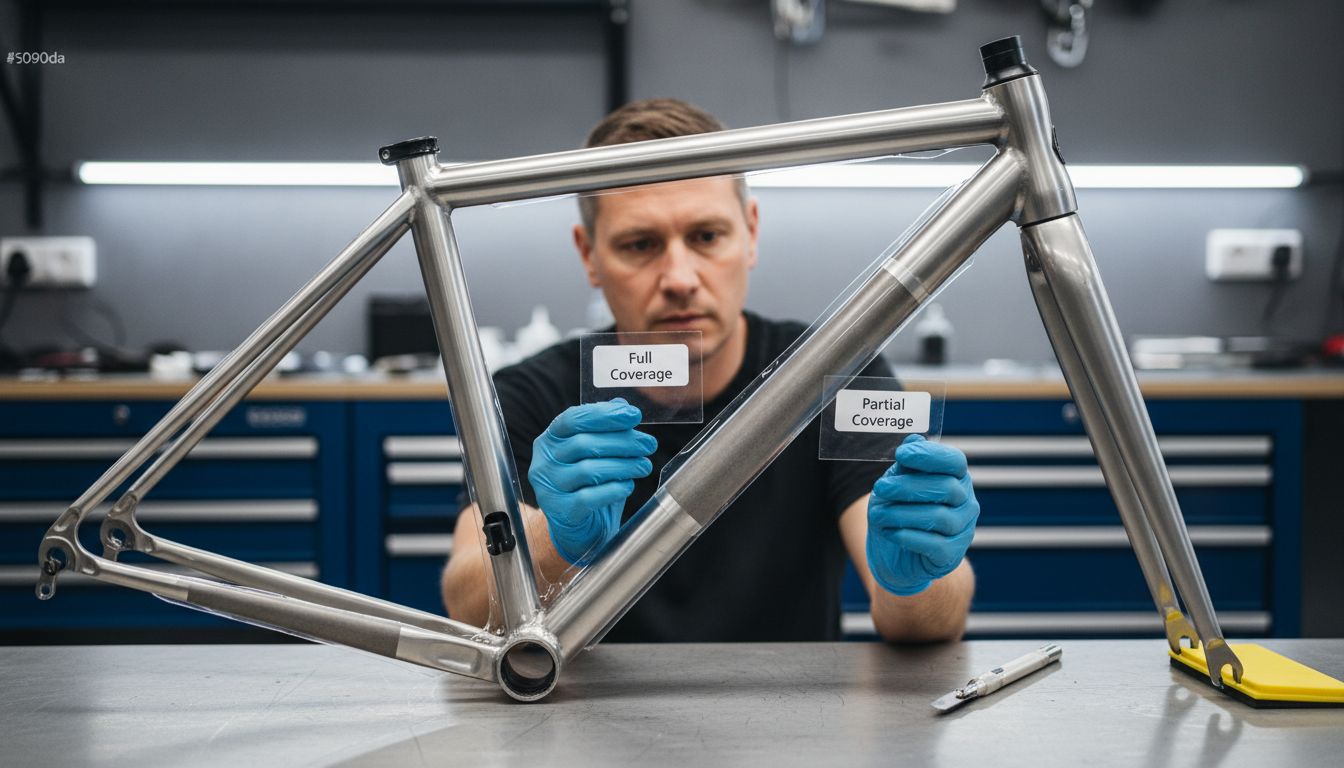
Scratches, chips, and fading paint can quietly eat away at your bike’s value and good looks. With the price of top-quality bicycles reaching thousands, protecting that investment matters more than ever. Paint protection film has emerged as the go-to solution, offering self-healing properties and discreet shield-like coverage that can keep your bike looking new no matter where or how you ride. Discover how this advanced technology can safeguard your ride for years to come.
Table of Contents
- Defining Bike Paint Protection Film
- Types of Bike-Specific Protection Films
- How Paint Protection Film Works
- Installation Methods for Bikes
- Costs, Maintenance, and Value Considerations
Key Takeaways
| Point | Details |
|---|---|
| Specialized Protection | Bike Paint Protection Film is designed specifically for bicycles, addressing unique wear patterns and safeguarding against damage. |
| Types of Films | Various types of PPF are available, including full frame, partial coverage, and performance-specific films to cater to different cyclist needs. |
| Installation Importance | Proper installation is crucial for effectiveness; thorough surface preparation and specialized tools are recommended for optimal results. |
| Long-Term Value | Investing in high-quality PPF not only preserves a bike’s appearance but also enhances its resale value and reduces maintenance costs over time. |
Defining Bike Paint Protection Film
Bike Paint Protection Film (PPF) is a specialised transparent protective layer designed specifically to safeguard bicycle surfaces from environmental and mechanical damage. According to RideWrap, this innovative film is constructed from thermoplastic polyurethane (TPU), engineered to withstand the unique challenges bicycles encounter during rides and storage.
Unlike automotive protection films, bicycle PPF is tailored to address the specific wear patterns and surface characteristics of bikes. ParkingDay highlights that high-quality PPF offers remarkable protective properties, including:
- Self-healing capabilities for minor scratches
- Transparent application that remains nearly invisible
- Protection against scratches, chips, and UV damage
- Durable material resistant to environmental stressors
The core purpose of bike paint protection film is preserving your bicycle’s aesthetic and structural integrity. Professional cyclists, passionate hobbyists, and casual riders alike can benefit from this protective technology, which acts as an invisible shield against the daily wear and tear that can diminish a bike’s appearance and value. By investing in a quality PPF, cyclists can maintain their bike’s pristine finish and protect their significant equipment investment.
With PPF for Motorcycles: 2025 Guide for Installers & Detailers, you can explore more advanced techniques and professional insights into paint protection technologies across different vehicle types.
Types of Bike-Specific Protection Films
Bike Protection Films come in multiple variants designed to address different cycling environments and rider needs. These specialised films can be categorised into several key types, each offering unique protective characteristics for bicycle surfaces.
Full Frame Protection Films
Full frame protection films provide comprehensive coverage for the entire bicycle frame, offering maximum defence against potential damage. These films are typically made from high-grade thermoplastic polyurethane (TPU) and are custom-cut to match specific bicycle frame geometries. They offer:
- Complete frame coverage
- Invisible protective layer
- Customisable fit for different bike models
- Protection against rock chips, scratches, and abrasions
Partial Coverage Films
Partial coverage films target specific vulnerable areas of the bicycle, such as the downtube, chainstays, and drivetrain components. These strategic protection solutions are ideal for riders who want targeted defence without full frame coverage. Cyclists can select:
- Specific component protection
- Lower cost compared to full frame films
- Easy replacement of individual sections
- Focused protection for high-impact zones
Performance-Specific Films
Performance-specific films are engineered for different cycling disciplines, including:
- Mountain bike protection films with enhanced rock and trail damage resistance
- Road bike films optimised for aerodynamic surfaces
- Gravel bike films with additional abrasion protection
- Racing bike films with ultra-thin, lightweight materials
With Understanding Interior Protection Films: Benefits for Luxury Cars, professional installers can gain insights into advanced protection technologies that can be adapted to various vehicle and bicycle protection needs.
Here’s a comparison of the main types of bike protection films:

| Film Type | Coverage Area | Key Benefits | Ideal For |
|---|---|---|---|
| Full Frame Protection | Entire bicycle frame | Maximum coverage Invisible shield Custom fit | Riders seeking comprehensive protection |
| Partial Coverage | Key vulnerable areas | Lower cost Easy replacement Targeted defence | Budget-conscious cyclists Frequent repairers |
| Performance-Specific | Discipline-tailored zones | Specialised resistance Lightweight Optimised for use | Mountain bikers Road cyclists Racers |
How Paint Protection Film Works
Paint Protection Film (PPF) is an advanced protective technology designed to shield bicycle surfaces from environmental and mechanical damage.
![]() According to Colorfuul, the film operates through a sophisticated multi-layer construction that provides comprehensive protection for bikes.
According to Colorfuul, the film operates through a sophisticated multi-layer construction that provides comprehensive protection for bikes.
Layered Protection Mechanism
The PPF’s intricate design consists of three critical layers, each serving a specific protective function:
- Top Nano-Coating Layer
- Repels water, dirt, and oil
- Creates a hydrophobic surface
- Enhances overall film durability
- Thermoplastic Polyurethane (TPU) Core
- Absorbs impacts from scratches and debris
- Provides primary structural protection
- Enables self-healing properties
- Adhesive Attachment Layer
- Ensures secure bonding to bicycle surface
- Prevents film shifting or peeling
- Allows precise, custom application
Self-Healing and Protective Capabilities
As ParkingDay highlights, high-quality PPFs offer remarkable self-healing capabilities. When minor scratches occur, the film’s molecular structure can return to its original state when exposed to heat, effectively ‘healing’ surface imperfections and maintaining the bicycle’s pristine appearance.
Bicycle paint protection films work by creating an invisible, durable barrier that absorbs and disperses potential damage.
Whether protecting against rock chips during mountain biking, preventing paint fade from UV exposure, or minimising scratch risks during storage and transport, PPF provides comprehensive surface defence.
For professional installers seeking deeper insights into paint protection technologies, How Does PPF Work? Guide for Car Care Pros 2025 offers advanced technical perspectives applicable across various vehicle protection applications.
Installation Methods for Bikes
Bike Paint Protection Film installation is a precision-driven process that requires careful preparation and specialized techniques. According to FrameWrapKing, successful application involves multiple critical steps designed to ensure maximum protection and optimal film adherence.
Professional Preparation Techniques
Surface preparation is the foundational stage of PPF installation. This involves:
- Thoroughly cleaning the bicycle frame with specialized degreasers
- Removing all contaminants and residues
- Creating a pristine surface for film application
- Ensuring complete dirt and oil removal
Installation Process
As detailed by 3DomWraps, the installation methodology includes several precise steps:
- Surface Degreasing
- Use professional-grade cleaning solutions
- Remove all potential contaminants
- Create optimal bonding conditions
- Film Positioning
- Utilize supplied installation diagrams
- Apply fitting solution to film and surface
- Carefully remove backing material
- Position film with minimal air bubbles
Essential Installation Tools
Successful PPF installation requires specialized equipment:
- Rubber squeegees for smooth application
- Spray bottles for fitting solutions
- Precision cutting tools
- Heat guns for final shaping and bonding
- Microfibre cloths for surface preparation
Professional installers understand that patience and precision are key. Rushing the process can lead to imperfections that compromise the film’s protective capabilities.
For advanced insights into professional installation techniques, explore Common Mistakes in PPF Installation and How to Avoid Them to refine your installation skills and deliver superior results.
Costs, Maintenance, and Value Considerations
Bike Paint Protection Film represents a strategic investment for cyclists seeking long-term bicycle preservation. While initial costs might seem significant, the comprehensive protection offered translates into substantial long-term value for both recreational and professional riders.
Cost Breakdown Analysis
Pricing factors for bike paint protection film vary based on several critical considerations:
Coverage Area
- Full frame protection: Higher cost
- Partial coverage: More budget-friendly
- Custom section protection: Variable pricing
Film Quality
- Entry-level films: £50-£150
- Professional-grade films: £150-£350
- Premium performance films: £350-£600
Maintenance Considerations
Proper maintenance significantly extends the lifespan and effectiveness of paint protection films:
- Regular gentle cleaning with microfibre cloths
- Avoiding harsh chemical cleaners
- Periodic professional inspection
- Immediate addressing of potential film damages
Long-Term Value Proposition
The true value of bike paint protection film extends beyond immediate cost considerations. Professional cyclists and serious enthusiasts recognize that:
- Prevents expensive paint restoration costs
- Maintains bicycle’s resale value
- Reduces long-term cosmetic degradation
- Provides psychological peace of mind during rides
For professional installers seeking deeper insights into film longevity and value assessment, Understanding Paint Protection Film Lifespan: Insights for Professionals 2025 offers comprehensive professional perspectives on maximizing PPF investment returns.
Elevate Your Bike Paint Protection Film Installation with Precision Cutting Solutions
Achieving flawless paint protection film application can be a challenge for installers aiming to deliver perfect coverage without material waste. The delicate process of custom-cutting bike-specific PPF demands accuracy and efficiency to guard against scratches, abrasions, and UV damage as described in the guide. Whether you are fitting full frame or performance-specific films, getting the exact pattern right is crucial to preserving your clients’ bike appearance and maximising your workflow.

Discover how AEONCUT’s advanced Paint Protection Film cutting software empowers professional installers and DIY specialists with pre-cut, customisable patterns that save time and reduce errors. Our cloud-based platform offers an extensive library designed to meet the unique contours of bicycle frames, ensuring a perfect fit every time. Take advantage of precision, minimal waste, and ongoing updates by visiting https://aeoncutsw.com, your trusted partner for industry-leading PPF software. Take the next step to streamline your paint protection film installation and impress your customers today.
Frequently Asked Questions
What is bike paint protection film and how does it work?
Bike paint protection film (PPF) is a transparent protective layer made from thermoplastic polyurethane (TPU) designed to protect bicycle surfaces from scratches, chips, and UV damage. It works by creating a durable barrier that absorbs impacts and is self-healing for minor scratches when exposed to heat.
What types of bike paint protection films are available?
There are three main types of bike paint protection films: full frame protection films, which cover the entire bike frame; partial coverage films, which target specific areas like downtubes and chainstays; and performance-specific films, which are designed for various cycling disciplines such as mountain biking or road racing, offering tailored protection.
How do I maintain my bike paint protection film?
To maintain your bike paint protection film, regularly clean it with a gentle microfibre cloth and avoid harsh chemical cleaners. Conduct periodic inspections for damages and seek professional help if needed to extend the film’s lifespan.
What is the typical cost of bike paint protection films?
The cost of bike paint protection films varies based on factors such as coverage area and film quality. Entry-level films can cost between £50-£150, while professional-grade films range from £150-£350, and premium performance films may cost between £350-£600.
Recommended
- PPF for Motorcycles: 2025 Guide for Installers & Detailers – AEONCUT PPF Pre-cut Cutting software
- How Does PPF Work? Guide for Car Care Pros 2025 – AEONCUT PPF Pre-cut Cutting software
- PPF vs Vinyl Wrap: Expert Guide for 2025 Car Care – AEONCUT PPF Pre-cut Cutting software
- Clear Bra vs PPF: Key Differences for Detailing Pros 2025 – AEONCUT PPF Pre-cut Cutting software
- How to Detail a Car for a Showroom Shine at Home



